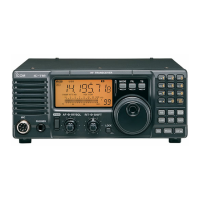N Programming a memory name
Memory messages can be tagged with alphanumeric
names of up to 30 characters each.
Capital letters, small letters, numerals, some symbols
(! # $ % & ¥ ? " ’ ` ^ + – 1 / . , : ; = < > ( ) [ ] { } | _
~
@) and spaces can be used. (See the table below.)
q Record a message as described in page ??.
w During the VOICE MIC-RECORD screen indica-
tion, push [NAME] (F-5) to enter memory name
edit condition.
• A cursor appears and blinks.
e Push [T1..T4] (F-6) several times to select the
desired voice message.
r Input the desired character by rotating the main
dial or by pushing the band key for number input.
• Push [ABC] (MF6) or [abc] (MF6) to toggle capital and
small letters.
• Push [123]
(MF7) or [Symbol] (MF7) to toggle numerals
and symbols.
• Push [
Ω] (F-1)
or [≈] (F-2) for cursor movement.
• Push [DEL] (F-3)
to delete the selected character.
• Push [SPACE] (F-4)
to input a space.
• Pushing the transceiver’s keypad, [0]–[9], can also
enter numerals.
t Push [EXIT/SET] to input and set the name.
• The cursor disappears.
y Repeat steps e to t to program another voice
message’s name, if desired.
u Push [EXIT/SET] twice to exit the voice recorder
screen.
• Usable characters
Key selection Editable characters
A to Z (capital letters)
a to z (small letters)
0 to 9 (numbers)
! # $ % & ¥ ? “ ‘ ` ^ + – 1
/ . , : ; = < > ( ) [ ] { } | _ ~
@
For your convenience
When a PC keyboard is connected to [USB] (A) con-
nector on the front panel, the memory name can also
be edited from the keyboard.
F-1 F-2 F-4
F-3 F-6
EXIT/SET
Main dial
Symbol ABC
123 abc
DEL
SPACE
T1..T4
Keypad
Voice memory name editing example
95
5
VOICE RECORDER FUNCTIONS

